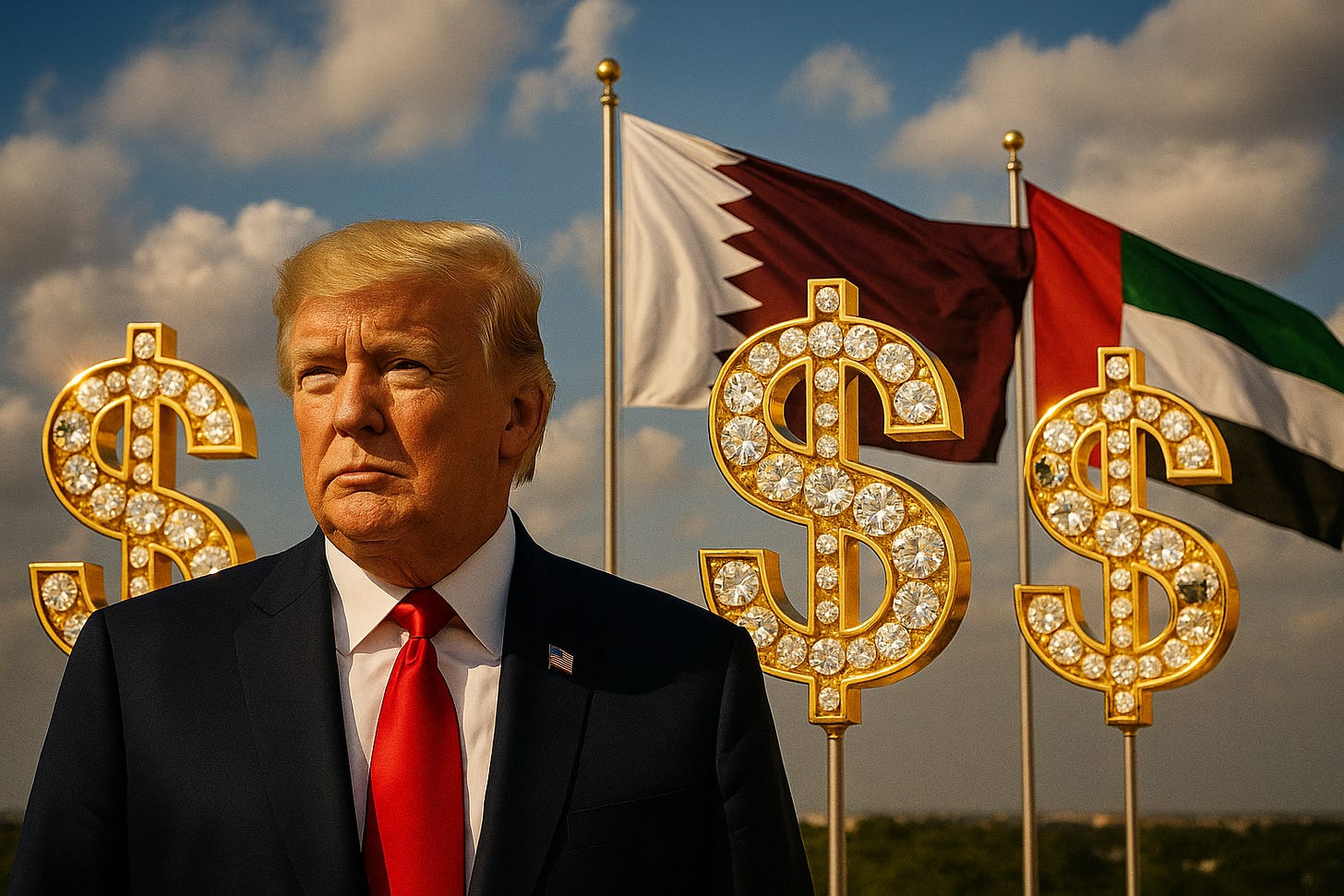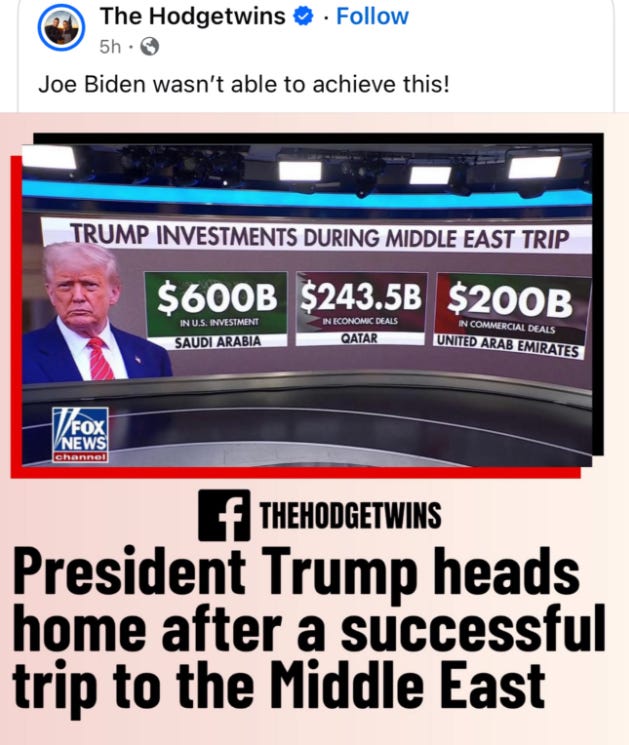Trump’s Trillion-Dollar Mirage: The Truth Behind Those Middle East ‘Deals
It's all a farce, but do you expect anything less?
Recent social media posts and news coverage highlight President Trump’s assertion that his recent Middle East trip secured unprecedented investment deals-figures like $600 billion from Saudi Arabia, $243.5 billion from Qatar, and $200 billion from the United Arab Emirates are prominently cited. The White House and supportive outlets have touted a total of over $2 trillion in economic agreements, characterizing the trip as a historic economic and diplomatic success.
But let’s get real: the numbers are more fantasy than fact. They’re not binding deals. They're not verified investments. And they definitely didn’t appear out of thin air because of one diplomatic trip.
Here’s what’s actually going on:
Trump’s team and media allies have claimed over $2 trillion in Middle East agreements. But when we do the math, we find that real, trackable contracts add up to less than $700 billion — and that’s being generous. Much of that number comes from non-binding pledges, press release promises, and deals that were already in motion before Trump’s trip. Some of these contracts have been recycled so many times they’re practically antiques.
Meanwhile, independent sources like Reuters and The Washington Post point out that many of these so-called “deals” are nothing more than memoranda of understanding — vague future intentions with no teeth. They're the diplomatic equivalent of saying, “Let’s grab lunch sometime” and calling it a restaurant opening.
Nature of the Agreements
Non-binding and Long-term: Many of the agreements are non-binding or represent intentions to collaborate over a decade or more, rather than immediate, guaranteed investments.
Sectoral Focus: The deals span sectors including defense, aviation, technology, and energy. For example, Saudi Arabia’s $600 billion commitment includes joint ventures with U.S. tech firms and infrastructure projects, but the breakdown of these figures is not always transparent.
Business as Usual: Experts emphasize that many of the largest deals-such as aircraft sales to Qatar Airways-would likely have occurred regardless of who was president, as they are driven by commercial needs and long-term business relationships.
And let’s not forget the political theater: U.S. presidents and Gulf states have long played this game — announce massive numbers, take a few photos, and go home to headlines about “historic deals.” The difference is that Trump turned that normal diplomatic fluff into a full-on branding campaign, hoping nobody would notice the fine print.
So no, this wasn’t an economic miracle. It was a carefully staged PR event, designed to look like a once-in-a-lifetime breakthrough. But peel back the layers, and it’s mostly smoke and spin — no matter how many flags they wrap around it.
Trump loves this kind of Inflation
While Trump’s team flaunted trillion-dollar graphics and golden photo ops, the actual diplomatic outcome of the Middle East trip was hollow. There were no peace breakthroughs in Gaza, Ukraine, or anywhere else—just a string of symbolic handshakes and headline-chasing press releases. Gulf leaders showered him with praise, but the substance was missing. Critics across the spectrum have pointed out that the administration’s obsession with big, flashy investment numbers conveniently masked the absence of real geopolitical progress.
And behind the curtain of choreographed deal-making? A deepening swirl of ethical concerns, as the Trump family’s business entanglements in the region quietly expanded. For all the talk of statesmanship, it looked a lot more like branding than diplomacy. But what else do we expect from our gaudy giddy grifter?
That being said, let’s take a look at one of the meme’s floating around. This one comes from the Hodge Twins.
Meme Analysis:
The meme claims that during a trip to the Middle East, President Trump secured over $1 trillion in investments and economic deals from Saudi Arabia ($600B), Qatar ($243.5B), and the UAE ($200B). It implies this was a major diplomatic and economic success that President Biden could never replicate.
2. Fact-Check:
This claim dramatically inflates and distorts the truth. Here's what actually happened:
The $600 billion number from Saudi Arabia is false.
During Trump's May 2017 visit to Saudi Arabia, the administration announced over $350 billion in total economic pledges, but much of it was aspirational, non-binding, or based on previously existing deals. The only concrete agreement was a $110 billion arms deal, which also included packages already in progress during the Obama administration.The Qatar and UAE numbers are fictional.
There is no official or verified record of $243.5B in deals with Qatar or $200B with the UAE tied directly to Trump’s visit. These numbers appear entirely fabricated for the graphic. Even Fox News, which aired similar graphics, was vague about what those figures actually represented — often lumping together memoranda of understanding, private investment discussions, and ambiguous long-term goals.These are not U.S. investments.
The phrase "$600B in U.S. investment" suggests America sent that money to Saudi Arabia. In reality, these were promises of investment from Saudi Arabia into the U.S., or arms purchases from U.S. defense contractors. The graphic flips the direction of the money to make it sound like Trump orchestrated outbound American investment.
3. Rhetorical Technique:
This meme uses false equivalency, numerical inflation, and jingoistic framing. It implies:
That Trump's “deals” were unique, real, and productive.
That Biden’s foreign policy is weak by comparison.
That televised deal-making optics equal economic success.
In reality, much of Trump’s Middle East diplomacy was theater. Deals were announced but not enforced, and the U.S. under Trump often pursued personal and political alliances with authoritarian Gulf states, even when they conflicted with long-term diplomatic goals or human rights principles.




